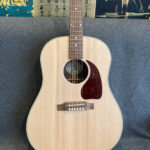The Bmaj7 Guitar Chord, a lush and sophisticated variation of the B major chord, adds a touch of elegance to your guitar playing. Whether you’re exploring jazz, pop, or even folk music, understanding and utilizing the Bmaj7 chord can significantly enrich your musical palette. This guide will delve into various ways to play the Bmaj7 chord, from open positions to barre chord shapes, along with essential theory and practical applications.
Unveiling the Bmaj7 Open Position
One of the most accessible ways to play the Bmaj7 guitar chord is in an open position. This voicing, while omitting the 5th (F#) for playability, still captures the essential character of the chord.
Bmaj7
X21302This diagram illustrates the finger placement for this open Bmaj7 guitar chord. It’s crucial to avoid strumming the 6th and 1st strings to achieve the intended sound. This voicing comprises the root (B), major third (D#), and major seventh (A#), creating the signature major 7th sound.
An open position diagram showing how to play the Bmaj7 guitar chord, indicating finger placement on the fretboard.
Exploring Alternative Bmaj7 Chord Shapes
Beyond the open position, mastering barre chord shapes expands your versatility and allows you to play the Bmaj7 guitar chord across the fretboard. Here are a few essential barre chord variations:
Bmaj7 Barre Chord (Root on 5th String)
This barre chord shape is based on the A major barre chord form, moved up two frets.
Bmaj7 Barre (5th string root)
799877To play this Bmaj7 barre chord, barre across the 7th fret and use your remaining fingers to form the shape. This shape is movable, allowing you to play other major 7th chords by shifting it along the neck.
A diagram illustrating the Bmaj7 barre chord shape with the root note on the 5th string, demonstrating finger placement.
Bmaj7 Barre Chord (Root on 6th String)
Another common barre shape for the Bmaj7 guitar chord originates from the E major barre chord form.
Bmaj7 Barre (6th string root)
X24342Barre across the 2nd fret and shape the chord using the E major form. This voicing offers a different tonal color compared to the previous shape and is equally useful.
A diagram presenting an alternative Bmaj7 barre chord shape with the root note on the 6th string, showcasing finger positions.
Bmaj7 Chord Theory and Musical Context
Understanding the theory behind the Bmaj7 guitar chord enhances your musical comprehension and application. The Bmaj7 chord is built from the major scale and consists of four notes:
- Root (1): B
- Major Third (3): D#
- Perfect Fifth (5): F#
- Major Seventh (7): A#
These notes combine to create the characteristic bright and jazzy sound of the major 7th chord.
Using Bmaj7 in Chord Progressions
The Bmaj7 chord is frequently used in major key progressions and often creates a smooth resolution or a sophisticated harmonic touch. Consider this common jazz progression:
C#m7 - F#7 - Bmaj7
This progression beautifully showcases the Bmaj7 as a resolution chord. Experiment with incorporating the Bmaj7 guitar chord into your own songwriting and improvisations to add depth and color.
Chord Naming Conventions
“Bmaj7” is the standard abbreviation for “B major seventh.” You might also encounter “BM7” or the symbol “B△7,” all referring to the same chord.
Capo and Bmaj7 Chord Variations
If you find certain Bmaj7 guitar chord shapes challenging, using a capo can provide alternative, easier voicings. For example:
- Capo on the 2nd fret and play Amaj7 shape: This effectively creates a Bmaj7 chord.
- Capo on the 4th fret and play Gmaj7 shape: This yields a Bmaj7 chord.
- Capo on the 7th fret and play Emaj7 shape: This also results in a Bmaj7 chord.
These capo variations offer different tonal qualities and can be helpful depending on the musical context and your hand dexterity.
Inversions and Slash Chords
Exploring inversions and slash chords further expands your Bmaj7 guitar chord vocabulary.
- Bmaj7/D# (1st Inversion): D# in the bass.
- Bmaj7/F# (2nd Inversion): F# in the bass.
- Bmaj7/A# (3rd Inversion): A# in the bass.
Slash chords, indicated with a note after the slash, denote a different bass note than the root. Here are some examples:
- Bmaj7/C:
X31302 - Bmaj7/C#:
X41302 - Bmaj7/E:
011302 - Bmaj7/G:
311002 - Bmaj7/G#:
464446
These variations offer unique sonic flavors and can create interesting bass lines and harmonic movement.
Tablature for Bmaj7 Open Position
Here’s the tablature for the main open position Bmaj7 guitar chord:
e|-2-|
B|-0-|
G|-3-|
D|-1-|
A|-2-|
E|-x-|This tab visually represents the finger placement on the fretboard for the open Bmaj7.
Conclusion
The Bmaj7 guitar chord is a valuable addition to any guitarist’s chord library. By mastering the various shapes, understanding the theory, and exploring its musical applications, you can unlock a richer and more expressive sound in your playing. Experiment with these voicings and discover how the Bmaj7 chord can enhance your musical journey.

